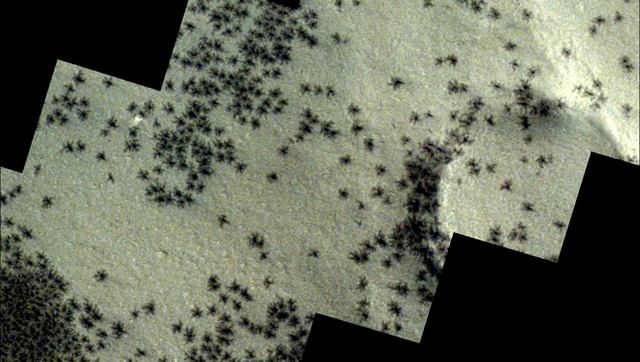The European Space Agency (ESA) released images of what appear to be thousands of spiders roaming around on Mars. But if you are afraid of spiders you need not worry because the pictures taken by ESA’s Mars Express only appear to be spiders from up in space.
The images were recorded in Mars’s “Inca City.” However, rather than being actual spiders, explained ESA, these small, dark features form when spring sunshine falls on layers of carbon dioxide deposited over the dark winter months. The sunlight causes carbon dioxide ice at the bottom of the layer to turn into gas, which subsequently builds up and breaks through slabs of overlying ice. The gas bursts free in Martian springtime, dragging dark material up to the surface as it goes and shattering layers of ice up to a meter thick.
Another of ESA’s Mars explorers, the ExoMars Trace Gas Orbiter (TGO), captured images of spiders lying near, but outside, the region. The Mars Express view shows the dark spots on the surface formed by escaping gas and material, while the TGO perspective also captures the spidery, web-like channels that are carved into the ice below.
Will you offer us a hand? Every gift, regardless of size, fuels our future.
Your critical contribution enables us to maintain our independence from shareholders or wealthy owners, allowing us to keep up reporting without bias. It means we can continue to make Jewish Business News available to everyone.
You can support us for as little as $1 via PayPal at office@jewishbusinessnews.com.
Thank you.
The Inca City on Mars, more formally known as Angustus Labyrinthus, is a captivating geological feature located near the Martian South Pole. It’s not an actual Inca city, of course, but from a distance, the network of valleys and ridges bear an uncanny resemblance to the ruins of ancient Inca structures like Machu Picchu on Earth.
Discovered in 1972 by the Mariner 9 probe, the Inca City is part of a much larger circular structure, likely caused by an ancient asteroid impact that cracked the Martian crust. Magma subsequently flowed through the cracks, eventually solidifying and forming the ridges we see today.
ESA explained the “walls” of Inca City appear to trace part of a large circle, 86 km in diameter. Scientists therefore suspect that the ‘city’ sits within a large crater that itself formed as a rock from space crashed into the planet’s surface. This impact likely caused faults to ripple through the surrounding plain, which were then filled with rising lava and have since worn away over time.
Since beginning science operations in 2004, ESA’s Mars Express has provided breathtaking views of Mars in three dimensions. It has provided the most complete map of the chemical composition of the atmosphere, studied Mars’s innermost moon Phobos in unprecedented detail, and traced the history of water across the globe, demonstrating that Mars once harbored environmental conditions that may have been suitable for life.




